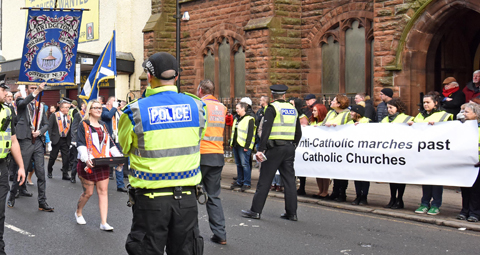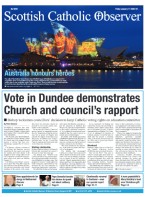BY Daniel Harkins | February 22 | ![]() 0 COMMENTS
0 COMMENTS ![]() print
print

Silent protest stands in defiance of Orange walk past attacked priest’s church
ONE hundred people formed a thin but resolute line against anti-Catholic bigotry last weekend as they said ‘no more’ to the endless, booming Oranges marches that plague the streets of Scotland.
On a cold February morning 200 people marched through Glasgow’s East End.
Their route took them up London Road, and past St Alphonsus’ Church.
Here, last July, as the same group paraded by, parishioners were attacked and abused as they left Mass. Parish priest Canon Tom White had been spat on as he hurriedly tried to usher his parishioners into the church.
Seven months later some of those parishioners gathered again outside the church, refusing to be chased of their streets for simply being a Catholic in Scotland.
As the marchers left Bridgeton Cross, a short walk to the east a heavy — and no doubt expensive — police presence took up positions around the church.
Dozens of police officers and police vehicles were in attendance, with one officer positioned across the street filming the line of Catholics before, during and after the parade.
Those present gathered at the entrance of the church to hear from Jeanette Findley of Call it Out.
The group, which campaigns against anti-Catholic bigotry and anti-Irish racism, was formed after the attack on Canon White, and had arranged a previous, all-women protest as an Orange walk went past St Michael’s Church in Parkhead in November.
“We are not here to take anyone’s rights away,” she said. “We are here to say, ‘you hate us, you’ve got a legal right to hate us, but you can’t make it our problem. You should not be walking past this chapel.’”
Across the street, the ‘hangers-on’ to the Orange walk, those who get the blame for the violence and anti-Catholic abuse that accompany the marches and the conduct of which the Order denies any responsibility, gathered ranks.
As they made sneering jokes about abuse, they took out their mobile phones and filmed the Catholics outside their parish.
“It’s intimidating,” one of those present said.
As the marchers arrived near the church, they were halted by police, and a 100 metre ban on music came into force. The Orange march continued past the church to sound of their drums.
The Call it Out group stood silently as they passed. The march supporters across the street broke out into cheers and applause. Many of those in the march took the opportunity to stare down the parish counter-protest, grinning ear-to-ear.
Among those in the counter-protest were representatives of trade unions, and non-Catholics there to show their support and stand against bigotry.
One parishioner of St Alphonsus’ said the marches had become normalised.
He pointed out that this wasn’t simply one march—it is one of dozens that will take place in the area throughout the year.
Sir John Orr’s 2005 Review of Marches and Parades in Scotland found that half of all processions in Scotland were Orange walks—with 853 taking place in in one year.
Since July, politicians across Scotland’s parties have stated their aim of reducing this number, and of ensuring their routes do not go past Catholic churches. So far, no steps have been taken towards this goal.
Contacted by the SCO last year after the attack on Canon White, Glasgow City Council said local authorities do not have the power to blanket block the conduct—for instance, the routes—of a public procession and that it is not permitted to take into account the number of parades undertaken by any particular organisation.
The Scottish Government meanwhile, when asked by the SCO if it would take action to prevent Orange walks going past Catholic churches in future, passed the buck to local authorities.
“Each local authority, in consultation with Police Scotland, is in the best position to decide whether a particular event should go ahead and whether any restrictions should be placed on it,” it said.
As parishioners awaited the return parade, police continued filming their silent protest. Police liaison officers said they were filming the march-supporters as well, though this did not appear evident.
Around 15 minutes later, the march returned. Having turned at Glasgow Cross, it marched down the Gallowgate.
A natural option to avoid conflict would have been to continue down that road, or to pass behind the church before turning back onto London Road at Bain Street. However, the marches took an immediate right turn, and went back past St Alphonsus’.
Again, the music stopped, and again the Call it Out group and its supporters stood in silent witness.
A sign held by five female members of the group stated their intention clearly, and outlined their aims in the coming months and into Scotland’s marching season. It read: “No anti-Catholic marches past Catholic churches.”










